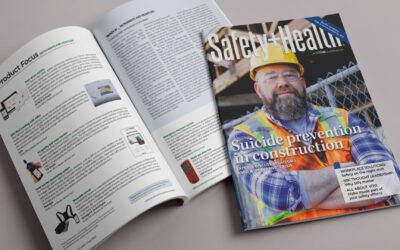Workplace safety should be a primary concern for everyone involved. A safety management system (SMS) helps employers systematically manage safety risks in their work operations. An SMS system is essential to improve safety within the workplace, enhancing existing processes and creating new operations to address hazards.
4 Components of Safety Management Systems
SMS systems are meant to provide methods and approaches to help businesses achieve a specific level of safety risk. There are four critical components of an SMS system:
1. Safety Policy
A safety policy helps establish management’s commitment to improving safety within the workplace. The policy defines specific practices, methods, processes and organizational structures necessary to achieve set safety goals. A safety policy aims to:
- Define safety goals and the commitment to achieving these goals.
- Establish transparency for safety management, which includes an outline of the policy and processes, a system for employee reporting and resolutions and methods for holding management and employees accountable.
- Build upon existing processes and procedures.
- Facilitate communication and cooperation across the organization.
2. Safety Risk Management
Safety risk management (SRM) helps assess the need and quality for new or revised risk controls based on the acceptable risk assessment. The SRM process is composed of four parts:
- Describing the system.
- Identifying potential and existing hazards.
- Assessing and analyzing the risks.
- Implementing methods to control the risk.
The SRM process is typically part of a business’s processes to provide its product or service.
3. Safety Assurance
Safety assurance (SA) evaluates the effectiveness of the risk control strategies a business has implemented while helping companies identify new potential hazards. The SA component of an SMS helps businesses feel confident they are meeting or exceeding their safety goals and requirements. Safety assurance ensures entities comply with safety requirements, compiling information on safety systems, analyzing data and assessing current systems.
Safety assurance provides valuable insight and analysis to help businesses improve their safety systems to minimize risk. This component of an SMS continues to evaluate safety practices to look for improved methods.

4. Safety Promotion
Safety promotion focuses on creating a positive safety culture in the workplace by implementing training, communication and other actions. Everyone in a business is responsible for creating a safe environment, from management to employees. Safety promotion helps advocate for a safer workplace, provides training and improves organizational communication.
12 Core Elements of Safety Management Systems
There are 12 elements within the four components of an SMS. These elements describe the specific need for a safety management system’s management, implementation and maintenance. Below are the 12 key elements of a health and safety management system and their corresponding components:
Elements of Safety Policies and Objectives
Safety policies and objectives are essential to include in company values for the safety of management and workers. The five elements of a quality safety policy include:
- Management commitment: A safety policy demonstrates the management’s commitment to safety. Employers should define safety goals as a policy while showcasing their commitment to helping the business meet them.
- Accountability and responsibilities: A safety policy should define the clear responsibilities of management to help maintain safety within the business. These responsibilities will help employers stay accountable as they implement new safety strategies.
- Safety personnel appointment: A safety policy should outline who has been defined as crucial safety personnel.
- Emergency response planning coordination: A safety policy needs to coordinate emergency response planning to ensure the safety of employees and management.
- Safety management system documentation: A safety policy should outline documentation processes so management can regularly review safety management systems to ensure they maintain their relevance and importance to the organization.
Elements of Safety Risk Management
There are two elements of safety risk management:
- Hazard identification: Hazards are conditions that can cause illness, injury or death to people. Hazards can also damage systems, equipment or property. Hazards can currently exist or become potential problems in the future. Identifying these hazards is essential to reduce the risk to employees and improve their safety.
- Safety risk assessment and mitigation: A risk assessment can help determine if a safety risk is acceptable. You can use software to assess safety risks and prioritize which risk to address in what order, so you can properly allocate resources. Once you’ve assessed the risks, you can put controls in place to mitigate the risks, which involves implementing safety measures to protect your workers, property and the environment.
Elements of Safety Assurance
Safety assurance involves monitoring risk controls during operations. There are three critical elements of safety assurance:
- Safety performance monitoring and measurement: Once you’ve implemented safety measures, monitor their effectiveness and performance to ensure they’re working properly. Keeping records such as internal audits, employee reporting systems and investigations can help you monitor and measure the success of your safety measures.
- Managing change: Sometimes, you’ll need to change your safety measures to ensure their success. Part of safety assurance is managing these changes and implementing them within your SMS.
- Implementing continuous improvements to the SMS: Many businesses will need to continuously work on their SMS to better safety in the workplace. These improvements can include increasing supervision, implementing training and performing maintenance.
Elements of Safety Promotion
Encouraging a safety culture is essential to help employees stay safe while on the job. Safety promotion has two elements:
- Training and education: Specific activities help support your implementation of an SMS, such as training programs that help employees understand safety goals and measures. Training can also help employees become aware of hazards in the workplace.
- Safety communication: Communication is essential in safety promotion, helping employees understand the safety management system and how they can report their safety concerns. Communication can help management make improvements to an SMS to mitigate hazards further.

Request a Trial of the SafeWork System From StrongArm Tech
Keeping your employees safe should be a priority. Our data-based system can help you improve your safety management system, allowing your employees to give their best at work and return home safely.
The StrongArm Tech SafeWork System utilizes cutting-edge technology to prevent workplace injuries and optimize your workforce. The SafeWork System uses real-time haptic feedback to help you correct unsafe behaviors that occur throughout the workday. You can use our simple tools and dashboard to analyze safety metrics, allowing you to implement necessary changes quickly.
Request a trial of our SafeWork System to see how it can revolutionize your workplace safety system!




